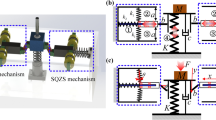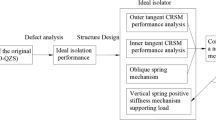Abstract
Nonlinear stiffness isolation mounts, which offer a high static stiffness alongside a low dynamic stiffness or even quasi-zero stiffness (QZS) over a displacement range, have been proposed. These vibration isolators offer a higher isolation frequency band of low transmissibility than conventional linear devices. Here, three kinds of nonlinear two degree-of-freedom (DOF) vibration isolators with QZS characteristic are analyzed in order to further improve the isolation performance. The dynamic response is obtained using the harmonic balance method, and the peak dynamic displacement is obtained using backbone curve analysis and energy balancing method. The optimum isolation performance of the nonlinear 2DOF vibration isolators is evaluated for four performance indexes and compared with three baseline vibration isolators. These are a linear and a QZS 1DOF vibration isolator as well as a linear 2DOF vibration isolator. To ensure a fair comparison, the static displacement of each vibration isolator is kept constant. The comparison demonstrates that a nonlinear 2DOF vibration isolator can be tuned to achieve a better isolation performance in the higher isolation frequency band than the baseline vibration isolators, while retaining a moderate peak dynamic displacement and peak transmissibility. In addition, the best vibration isolator is identified for each of the four performance indexes.
















Similar content being viewed by others
References
Harris, C.M., Piersol, A.G.: Shock and Vibration Handbook. McGraw-Hill, New York (2002)
Ibrahim, R.A.: Recent advances in nonlinear passive vibration isolators. J. Sound Vib. 314(3–5), 371–452 (2008)
Alabuzhev, P., Gritchin, A., Kim, L., Migirenko, G., Chon, V., Stepanov, P.: Vibration Protecting and Measuring System with Quasi-Zero Stiffness. Hemisphere Publishing, New York (1989)
Carrella, A., Brennan, M.J., Waters, T.P.: Static analysis of a passive vibration isolator with quasi-zero-stiffness characteristic. J. Sound Vib. 301(3–5), 678–689 (2007)
Carrella, A., Brennan, M.J., Waters, T.P., Lopes Jr., V.: Force and displacement transmissibility of a nonlinear isolator with high-static-low-dynamic stiffness. Int. J. Mech. Sci. 55(1), 22–29 (2012)
Xu, D., Zhang, Y., Zhou, J., Lou, J.: On the analytical and experimental assessment of performance of a quasi-zero-stiffness isolator. J. Vib. Control (2013). doi:10.1177/1077546313484049
Le, T.D., Ahn, K.K.: A vibration isolation system in low frequency excitation region using negative stiffness structure for vehicle seat. J. Sound Vib. 330(26), 6311–6335 (2011)
Le, T.D., Ahn, K.K.: Experimental investigation of a vibration isolation system using negative stiffness structure. Int. J. Mech. Sci. 70, 99–112 (2013)
Le, T.D., Ahn, K.K.: Fuzzy sliding mode controller of a pneumatic active isolating system using negative stiffness structure. J. Mech. Sci. Technol. 26(12), 3873–3884 (2012)
Platus, D.L.: Negative-stiffness-mechanism vibration isolation systems. In: Proceedings of SPIE’s International Symposium on Optical Science, Engineering, and Instrumentation, pp. 98–105. (1999)
Yang, J., Xiong, Y., Xing, J.: Dynamics and power flow behaviour of a nonlinear vibration isolation system with a negative stiffness mechanism. J. Sound Vib. 332(1), 167–183 (2013)
Liu, X., Huang, X., Hua, H.: On the characteristics of a quasi-zero stiffness isolator using Euler buckled beam as negative stiffness corrector. J. Sound Vib. 332(14), 3359–3376 (2013)
Huang, X., Liu, X., Sun, J., Zhang, Z., Hua, H.: Vibration isolation characteristics of a nonlinear isolator using Euler buckled beam as negative stiffness corrector: a theoretical and experimental study. J. Sound Vib. 333(4), 1132–1148 (2014)
Shaw, A.D., Neild, S.A., Wagg, D.J.: Dynamic analysis of high static low dynamic stiffness vibration isolation mounts. J. Sound Vib. 332(6), 1437–1455 (2013)
Shaw, A.D., Neild, S.A., Wagg, D.J., Weaver, P.M., Carrella, A.: A nonlinear spring mechanism incorporating a bistable composite plate for vibration isolation. J. Sound Vib. 332(24), 6265–6275 (2013)
Lan, C.C., Yang, S.A., Wu, Y.S.: Design and experiment of a compact quasi-zero-stiffness isolator capable of a wide range of loads. J. Sound Vib. 333(20), 4843–4858 (2014)
Zhou, J., Xu, D., Bishop, S.: A torsion quasi-zero stiffness vibration isolator. J. Sound Vib. 338, 121–133 (2015)
Zhou, J., Wang, X., Xu, D., Bishop, S.: Nonlinear dynamic characteristics of a quasi-zero stiffness vibration isolator with cam-roller-spring mechanisms. J. Sound Vib. 346, 53–69 (2015)
Liu, C., Jing, X.: Vibration energy harvesting with a nonlinear structure. Nonlinear Dyn. (2016). doi:10.1007/s11071-016-2630-7
Robertson, W.S., Kidner, M.R.F., Cazzolato, B.S., Zander, A.C.: Theoretical design parameters for a quasi-zero stiffness magnetic spring for vibration isolation. J. Sound Vib. 326(1–2), 88–103 (2009)
Zhou, N., Liu, K.: A tunable high-static low-dynamic stiffness vibration isolator. J. Sound Vib. 329(9), 1254–1273 (2010)
Xu, D., Yu, Q., Zhou, J., Bishop, S.: Theoretical and experimental analyses of a nonlinear magnetic vibration isolator with quasi-zero-stiffness characteristic. J. Sound Vib. 332(14), 3377–3389 (2013)
Huang, X., Liu, X., Sun, J., Zhang, Z., Hua, H.: Effect of the system imperfections on the dynamic response of a high-static-low-dynamic stiffness vibration isolator. Nonlinear Dyn. 76(2), 1157–1167 (2014)
Huang, X., Liu, X., Hua, H.: Effects of stiffness and load imperfection on the isolation performance of a high-static-low-dynamic-stiffness non-linear isolator under base displacement excitation. Int. J. Nonlinear Mech. 65, 32–43 (2014)
Shaw, A.D., Neild, S.A., Friswell, M.I.: Relieving the effect of static load errors in nonlinear vibration isolation mounts through stiffness asymmetries. J. Sound Vib. 339, 84–98 (2015)
Abolfathi, A., Brennan, M.J., Waters, T.P., Tang, B.: On the effects of mistuning a force-excited system containing a quasi-zero-stiffness vibration isolator. J. Vib. Acoust. 137(4), 044502 (2015)
Gorman, R.M.: Design and advantage of a two-stage mounting system for major machine in ships’ engine room. Shock. Vib. Bull. 35 (1966)
Wang, Y., Chen, C.G., Hua, H.X., Shen, R.Y.: Optimal design of ship floating raft system power equipment. Shipbuild. China 42(1), 45–49 (2001)
Lu, Z., Brennan, M.J., Yang, T., Li, X., Liu, Z.: An investigation of a two-stage nonlinear vibration isolation system. J. Sound Vib. 332(3), 1456–1464 (2013)
Lu, Z., Yang, T., Brennan, M.J., Li, X., Liu, Z.: On the performance of a two-stage vibration isolation system which has geometrically nonlinear stiffness. J. Vib. Acoust. 136(6), 064501 (2014)
Wagg, D.J., Neild, S.A.: Nonlinear Vibration with Control. Springer, New York (2009)
Hill, T.L., Cammarano, A., Neild, S.A., Wagg, D.J.: An analytical method for the optimisation of weakly nonlinear systems. Proceedings of EURODYN, pp. 1981–1988. (2014)
Hill, T.L., Cammarano, A., Neild, S.A., Wagg, D.J.: Interpreting the forced responses of a two-degree-of-freedom nonlinear oscillator using backbone curves. J. Sound Vib. 349, 276–288 (2015)
Peeters, M., Viguié, R., Sérandour, G., Kerschen, G., Golinval, J.C.: Nonlinear normal modes, part II: toward a practical computation using numerical continuation techniques. Mech. Syst. Signal Process. 23(1), 195–216 (2009)
Acknowledgements
The research described in this paper is supported by the Fundamental Research Funds for the Central Universities (Grant No. NZ2015103), the open project of State Key Laboratory for Strength and Vibration of Mechanical Structures (Grant No. SV2015-KF-01) and the National Natural Science Foundation of China (Grant No. 51675262). In addition, Yong Wang is supported as a visiting doctoral student at the University of Bristol by the Chinese Scholarship Council (Grant No. 201506830023) and Simon A. Neild is supported by the EPSRC Fellowship EP/K005375/1.
Author information
Authors and Affiliations
Corresponding author
Appendix
Appendix
1.1 The GG Model
The dynamic equation of the GG Model under force excitation at the static equilibrium position is given by
Using a Taylor series expansion, Eq. (31) can be approximated as
Following the same non-dimensional procedure described in Sect. 4, Eq. (32) can be written as
The resulting amplitude–frequency relationships of the GG Model can be obtained
where \(\mathbf{K}_\mathbf{1} =\left[ {{\begin{array}{ll} {\alpha _1 }&{} {-v} \\ {-v}&{} {v+\alpha _2 } \\ \end{array} }} \right] \), \(\mathbf{K}_\mathbf{3} =\left[ {{\begin{array}{ll} {\gamma _1 }&{} 0 \\ 0&{} {\gamma _2 } \\ \end{array} }} \right] \), \(\mathbf{X}^{\left( \mathbf{3} \right) }=\left[ {{\begin{array}{ll} {X_\mathrm{m}^3 }&{} 0 \\ 0&{} {X_\mathrm{am}^3 } \\ \end{array} }} \right] \), and the other parameters in Eq. (34) are the same with the parameters shown in Sect. 4.
The transmitted force of the GG Model is given as
where \(\mathbf{C}_\mathbf{t} =\left[ {{\begin{array}{ll} 0&{} {2\sigma \zeta _2 } \\ \end{array} }} \right] \), \(\mathbf{K}_{\mathbf{t1}} =\left[ {{\begin{array}{ll} {\alpha _1 -v}&{} {\alpha _2 } \\ \end{array} }} \right] \) and \(\mathbf{K}_{\mathbf{t3}} =\left[ {{\begin{array}{ll} {\gamma _1 }&{} {\gamma _2 } \\ \end{array} }} \right] \).
Using Eqs. (34) and (35), the amplitude of the force is written as
where \({\varvec{\Phi }}_\mathbf{t} =\left[ {{\begin{array}{ll} {\cos \Phi _t }&{} {\sin \Phi _t } \\ \end{array} }} \right] \). The force transmissibility of the GG Model can be obtained
Finally, using the backbone curve analysis and energy balancing method described in Sect. 4, the peak dynamic displacement of the GG Model can be determined from the following sets of equations
1.2 The TG Model
The dynamic equation of the TG Model under force excitation at the static equilibrium position is given by
Using a Taylor series expansion, Eq. (39) can be approximated as
Following the same non-dimensional procedure described in Sect. 4, Eq. (40) can be written as
The resulting amplitude–frequency relationships of the TG Model can be obtained
where \(K_1 =\left[ {{\begin{array}{ll} {\alpha _1 +\alpha _2 -\beta }&{} {-\left( {v+\alpha _2 -\beta } \right) } \\ {-\left( {v+\alpha _2 -\beta } \right) }&{} {v+\alpha _2 } \\ \end{array} }} \right] \), \(K_3 =\left[ {{\begin{array}{ll } {\gamma _1 }&{} {\gamma _2 } \\ 0&{} {-\gamma _2 } \\ \end{array} }} \right] \),
parameters defined in Sect. 4.
The transmitted force of the TG Model is given as
where \(C_t =\left[ {{\begin{array}{ll} 0&{} {2\sigma \zeta _2 } \\ \end{array} }} \right] \), \(K_{t1} =\left[ {{\begin{array}{ll} {\alpha _1 -v}&{} \beta \\ \end{array} }} \right] \) and \(K_{t3} =\left[ {{\begin{array}{ll} {\gamma _1 }&{} 0 \\ \end{array} }} \right] \).
Using Eqs. (42) and (43), the amplitude of the force is written as
The force transmissibility of the TG Model can be obtained
Finally, using the backbone curve analysis and energy balancing method described in Sect. 4, the peak dynamic displacement of the TG Model can be determined from the following sets of equations
Rights and permissions
About this article
Cite this article
Wang, Y., Li, S., Neild, S.A. et al. Comparison of the dynamic performance of nonlinear one and two degree-of-freedom vibration isolators with quasi-zero stiffness. Nonlinear Dyn 88, 635–654 (2017). https://doi.org/10.1007/s11071-016-3266-3
Received:
Accepted:
Published:
Issue Date:
DOI: https://doi.org/10.1007/s11071-016-3266-3




